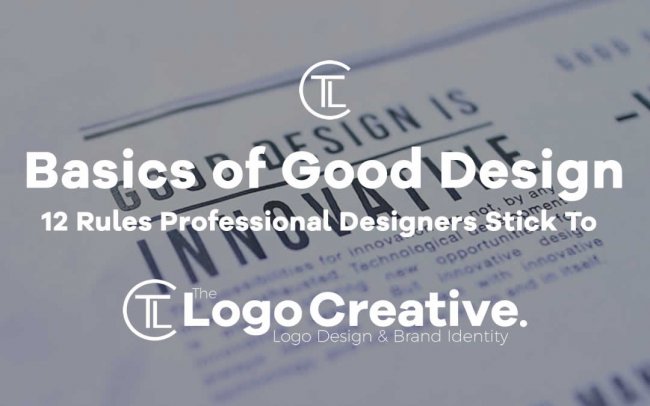Whether you’re a professional designer, a beginner designer, or a webmaster that’s looking for the basics of web and graphic design, you should be aware of one thing: Just like writing, coding, or language learning, designing is primarily a skill. It can become art if passion, knowledge, expertise, and experience are each present. Either way, you cannot master a skill and you cannot design art unless you have a solid foundation. Well, for that reason, in today’s article we discuss The Basics of Good Design: 12 Rules Professional Designers Stick To
In this article we cover 12 basic rules of aesthetic design, rules followed by most contemporary professional designers. By acknowledging these rules, you’ll be able to focus and practice each good advice in your future pursuits. If you won’t practice, reading this article is just like showering to smell good before an intense workout training – useless, because you’ll have to do it again after.
Table of Contents
Quality over Quantity
I’ll start with the mental basics, which in my opinion is critical to developing the aesthetic design. Quality versus quantity – that’s the mindset that will take you far in life and in business. Regardless of your career type, goals, and circumstances, try to over deliver in 99% of the time.
That doesn’t mean you must sacrifice your work in order to achieve perfection, no, that’s a thin line that mustn’t be crossed. What I’m talking about is pouring passion and true compassion into your work. I’m talking about creating one amazing design instead of three mediocre ones.
Take one client that pays $1000 rather than taking ten that pay $100 each. Focus on getting really good at something rather, don’t focus on becoming average at everything. You’ve got the point.
Smart versus Hard Work
Let me give you a personal example, just to help you understand how I perceive the difference between hard and smart work. As a student, you can get A+ grades only if you work hard, but also smart.
When i was in university i would have a good relationship, and keep in contact with my mentors and people in the industry that i admired, when i needed some help to figure something out or the best way to explain something i would seek advice from these people, and they would be glad to help me. It always helps to have good people around you that can support and guide you in the right direction.
Well, when it comes to designing, you need to think in terms of available resources. Everything from people to tools represents a resource and a possible bridge for optimization.
Tools and people help you save time, energy, and focus, allowing you to do whatever you are able to do best. Doing whatever you’re talented at and outsourcing the rest is the smart work I’m talking about, or the key to remarkable results in every area, especially in the design industry.
Great Design is Backed by Great Content and Marketing
Great design should always be backed by great content and great marketing and vice versa.
Think of design as the interior design of a restaurant. The restaurant’s outside design is marketing, while the food is the product. People won’t choose the restaurant if it doesn’t look appealing on the outside (marketing), they won’t stay if the interior design and the atmosphere is poor (design) and they surely won’t come back if the food is tasteless (product/service).
Whenever we think of design in terms of UX, then exceptional content and marketing are truly a must.
Speak Through Design, Not Through Words
Speaking through words rather than through design is one of the most common mistakes committed by amateur designers. The overuse of text in design is unnecessary and unprofessional.
This mistake is often committed when designers create infographics, slides, or even social media posts and stories. Remember: a photo can speak a thousand words, and so does a graphic element.
As a rule, try to limit the use of words and do your best to convey your message through well-designed and well-placed visual elements.
Font Matching is Critical
Start keeping in mind a simple rule: don’t mix more than 3 fonts and try to go for 2 if possible. When you exaggerate with fonts, your design will start feeling chaotic because it’s almost impossible to get that perfect combination that’ll “flow” naturally and will look appealing at the same time.
In case you want to try a variation, simply do a variation by changing the font rather than adding a new one. Try to achieve that balance by trying italic, bold, or even underlined text.
Colors are Key
The colors you choose for your designs is extremely important. It’s critical what you choose, and how you combine your choices.
The first part is what. I’d highly suggest you study color psychology. If you move past that and get into chromotherapy (which I’d highly suggest you to), you’ll find a lot of patterns and knowledge that’ll help you understand and leverage colors for psychological purposes.
When you combine psychology and design and use them together as one, you’re one step closer to art.
Negative Space is Essential
As human beings, we thrive when we get enough space to thrive. If distractions and limitations arise, we’ll lose focus and get stuck. It works exactly the same way with design. A very important rule is to balance your design by allowing enough negative space/blank space.
People’s minds are already cluttered by the time they’ll reach your design. Family, work, problems, needs, countless distractions, countless ads – these leave marks.
When people stumble upon blocks of text, they often bounce off the page. It works exactly the same way if the design feels too heavy or clogged.
Users Always Come First
In design, the user should always come first. When you design something because you’re paid to do so, you need to make your employer understand that he must aim for a balance between his way of seeing things and the way users see things.
If you’re designing for your own purposes, I’ll say the same thing. Make sure you understand what users are used to, what they prefer, and what they’d like to see. Balance that with your idea of things, but never neglect the user’s opinion.
Mental Clarity and Self-Organization
Exceptional designing is achieved by individuals who are able to master themselves and their mind. Mental clarity is a rare trait nowadays. People who possess clarity understand the meaning behind their work, they understand the long-term picture, and they often pursue great things.
A great designer needs mental space, and he needs to know how to use that space in order to properly organize and manage his work. But wait. Not just his work, because designers are also human beings. The professional and personal life are interconnected, so both of them will need to be balanced, for the greater balance and mental clarity to arise.
No Attachment
A key rule to successful design is the principle of no attachment. When you start doing something and you pay energy, focus, and time to obtain a satisfying result, you become attached to the idea that you’ve spent too many resources to simply “throw it away”.
This subtle yet disastrous form of attachment represents a big setback in any designer’s path. You should love your work, but never get attached to it. Respect your time, but never get obsessed with it. Work hard, but don’t sacrifice personal life because you’re too attached to work.
So think of attachment in terms of design. When you’re crafting art, you should be able to easily remove elements as you progress. If intuition tells you that this is not right, don’t be afraid to start a new design from scratch. Leave the present one in a draft, just for consolation, and start working on the next.
Less is More – Less is Better
Less is more, less is better. You have to think about this and test it on your own skin to acknowledge and understand the truth this statement hides.
This rule and concept is very similar to the “quality over quantity” principle, and also to the “hard work / smart work” principle. To truly understand this concept, check out Pareto’s 80/20 principle.
Constantly “Steal” Knowledge and Inspiration
The last golden rule I’ll spell today sounds like this: study the master’s work and steal from his knowledge. Get inspired, get motivated, get ready, and build the faith needed to thrive through another person’s art.
Find people that truly inspire you and study their works, techniques, lives, mindsets, and perspectives. Great designers are present everywhere – you just need to find those that fit your unique style and perspective. If they live, get in touch with them and follow your dream of reaching the same degree of mastery as they have, or even higher.
Takeaways
I often ask people “How do you read books, and why?”. What I truly seek to find is people like me, who are satisfied even if they’ve learned one or two precious things from an ocean of useless things.
If this post has given you some insight, inspiration, motivation, make sure you don’t waste it by approaching a passive behavior. Start planning the way you’ll implement these important basics of design into your work, and then start doing it!
We hope this article about The Basics of Good Design: 12 Rules Professional Designers Stick To has been helpful, and feel free to leave your comments below we love hearing from our readers.
 Author Bio
Author Bio
Lauren Adley is a writer and editor at UK Best Essays. She is dedicated to her family, work and friends. She is keen on reading, playing the guitar and traveling. She is interested in educational, marketing and blogging.

